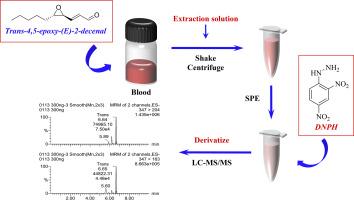优化LC-MS/MS法检测反式4,5-环氧-(E)-2-癸烯醛:推进人体挥发性有机化合物生物标志物研究
IF 4.9
2区 化学
Q1 CHEMISTRY, ANALYTICAL
引用次数: 0
摘要
挥发性有机化合物(VOCs)在人体生理中起着至关重要的作用,其浓度是人体生理状态的关键指标。其中,反式4,5-环氧-(E)-2-癸烯醛是一种在哺乳动物血液中发现的挥发性有机化合物,由于其分子结构与脂质过氧化过程密切相关,因此具有独特的化学反应性和嗅觉敏感性。然而,传统的检测方法,如气相色谱-嗅觉-质谱(GC-O-MS),存在固有的主观性、重现性差、操作要求严格、通量低等局限性,影响了其临床可靠性。为了解决这些问题,本研究开发了一种优化的液相色谱-串联质谱(LC-MS/MS)方法,用于准确的定性和定量分析。考虑到LC-MS/MS对醛类化合物的可检出性较差,采用2,4-二硝基苯肼(DNPH)衍生化来提高目标化合物的色谱行为和保留率。此外,采用高效液相色谱固相萃取(SPE)柱进行纯化,提高LC-MS/MS检测反式4,5-环氧-(E)-2-癸烯醛的灵敏度。衍生化后,反式4,5-环氧-(E)-2-癸烯醛在色谱分离中表现出很强的保留率。由乙腈和超纯水组成的流动相表现出明显优于乙腈和乙酸铵缓冲液组合的流动相。在优化条件下,LC-MS/MS法在1 ~ 300 ng/mL范围内线性良好,相关系数(R2)为0.9984,检出限(LOD)为0.3 ng/mL。实验中加标血样的相对标准偏差(RSD)为12.53%。本文章由计算机程序翻译,如有差异,请以英文原文为准。

Optimized LC-MS/MS approach for trace detection of trans-4,5-epoxy-(E)-2-decenal: Advancing volatile organic compounds biomarker research in human
Volatile organic compounds (VOCs) play a critical role in human physiology, with their concentrations serving as key indicators of physiological states. Among these, trans-4,5-epoxy-(E)-2-decenal, a volatile organic compound found in mammalian blood, exhibits unique chemical reactivity and olfactory sensitivity due to its molecular structure, which is closely associated with lipid peroxidation processes. However, conventional detection methods, such as gas chromatography-olfactometry-mass spectrometry (GC-O-MS), suffer from limitations including inherent subjectivity, poor reproducibility, stringent operational requirements, and low throughput, which undermine their clinical reliability. To address these challenges, this study developed an optimized liquid chromatography-tandem mass spectrometry (LC-MS/MS) method for accurate qualitative and quantitative analysis. Given the poor detectability of aldehydes via LC-MS/MS, 2,4-dinitrophenylhydrazine (DNPH) derivatization was employed to enhance the chromatographic behavior and retention of the target compound. Additionally, HLB solid-phase extraction (SPE) columns was employed for purification to enhance the sensitivity of LC-MS/MS for the detection of trans-4,5-epoxy-(E)-2-decenal. Following derivatization, trans-4,5-epoxy-(E)-2-decenal demonstrated strong retention during chromatographic separation. The mobile phase, composed of acetonitrile and ultrapure water, exhibited significantly superior performance compared to combinations of acetonitrile with ammonium acetate buffer. Under optimized conditions, the LC-MS/MS method demonstrated excellent linearity for trans-4,5-epoxy-(E)-2-decenal within a range of 1–300 ng/mL, with correlation coefficient (R2) of 0.9984, detection limit (LOD) of 0.3 ng/mL. The relative standard deviation (RSD) for spiked blood samples in the experiment was 12.53 %.
求助全文
通过发布文献求助,成功后即可免费获取论文全文。
去求助
来源期刊

Microchemical Journal
化学-分析化学
CiteScore
8.70
自引率
8.30%
发文量
1131
审稿时长
1.9 months
期刊介绍:
The Microchemical Journal is a peer reviewed journal devoted to all aspects and phases of analytical chemistry and chemical analysis. The Microchemical Journal publishes articles which are at the forefront of modern analytical chemistry and cover innovations in the techniques to the finest possible limits. This includes fundamental aspects, instrumentation, new developments, innovative and novel methods and applications including environmental and clinical field.
Traditional classical analytical methods such as spectrophotometry and titrimetry as well as established instrumentation methods such as flame and graphite furnace atomic absorption spectrometry, gas chromatography, and modified glassy or carbon electrode electrochemical methods will be considered, provided they show significant improvements and novelty compared to the established methods.
 求助内容:
求助内容: 应助结果提醒方式:
应助结果提醒方式:


